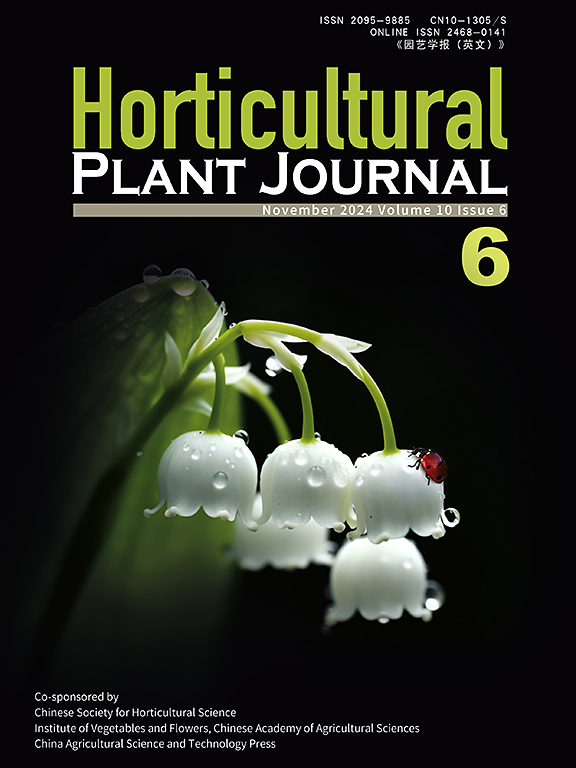The effect of adding residual humic acid biodegradable film on agronomic performance of potted tomato under greenhouse conditions
IF 6.2
1区 农林科学
Q1 HORTICULTURE
引用次数: 0
Abstract
Biodegradable plastic film provides a new way to solve “white pollution”. However, there is an urgent need to solve the problems of residual plastic film and tail vegetable pollution after planting. Currently, the continuous degradation of polyethylene plastic film and biodegradable plastic film after returning to the field and their impact on soil environment and vegetable crop growth need further research. This study is expected to provide some theoretical support through residual membrane addition experiments. We uniformly buried PBAT/PLA humic acid biodegradable film (BIO1), PBAT/PLA-lignin biodegradable film (BIO2), and polyethylene film (PE) at 200 kg film residue per ha in potted soil. After burial 120 d, the crystallinity of BIO1 and BIO2 residue decreased by 7.37 % and 3.91 % respectively, compared to that of PE. Additionally, the water contact angle of BIO1 and BIO2 film was lower, and the weight loss rate significantly increased. Microplastics (polyethylene) abundance in the PE treatment substrate was 166.67 ± 169.96 n kg温室条件下添加残留腐植酸生物降解膜对盆栽番茄农艺性能的影响
生物降解塑料薄膜为解决“白色污染”提供了新的途径。但种植后的残膜和尾菜污染问题亟待解决。目前,聚乙烯地膜和生物降解地膜还田后的持续降解及其对土壤环境和蔬菜作物生长的影响有待进一步研究。本研究有望通过残膜添加实验提供一定的理论支持。我们在盆栽土壤中按200 kg膜残量均匀埋埋PBAT/PLA腐植酸可生物降解膜(BIO1)、PBAT/PLA-木质素可生物降解膜(BIO2)和聚乙烯膜(PE)。掩埋120 d后,与PE相比,BIO1和BIO2的结晶度分别下降了7.37%和3.91%。此外,BIO1和BIO2膜的水接触角降低,失重率显著提高。埋置150天后,PE处理基质中微塑料(聚乙烯)丰度为166.67±169.96 n kg−1,而BIO1和BIO2处理中未发现微塑料(PBAT/PLA)。残膜降低了2-1 mm和2 mm水稳性团聚体的比例,增加了0.25 mm水稳性团聚体的比例,导致土壤压实和水分向上迁移;降低了底物中脲酶和蔗糖酶的活性,进一步降低了根系活力,增加了叶片脯氨酸含量,最终降低了番茄产量。但与PE相比,BIO1具有较低的底物容重、较高的通气孔率、减轻土壤压实、较强的底物酶活性和根系活性的特点,残留量显著提高了土壤子囊菌的相对丰度,显著降低了动物真菌的相对丰度;降低叶片脯氨酸含量,显著提高番茄产量,番茄红素含量显著提高12.80%,改善番茄品质。综上所述,200 kg ha−1的腐殖酸可生物降解地膜可提高番茄品质,减少“白色污染”,减少日光温室中因地膜残留造成的微塑料残留。
本文章由计算机程序翻译,如有差异,请以英文原文为准。
求助全文
约1分钟内获得全文
求助全文
来源期刊

Horticultural Plant Journal
Environmental Science-Ecology
CiteScore
9.60
自引率
14.00%
发文量
293
审稿时长
33 weeks
期刊介绍:
Horticultural Plant Journal (HPJ) is an OPEN ACCESS international journal. HPJ publishes research related to all horticultural plants, including fruits, vegetables, ornamental plants, tea plants, and medicinal plants, etc. The journal covers all aspects of horticultural crop sciences, including germplasm resources, genetics and breeding, tillage and cultivation, physiology and biochemistry, ecology, genomics, biotechnology, plant protection, postharvest processing, etc. Article types include Original research papers, Reviews, and Short communications.
 求助内容:
求助内容: 应助结果提醒方式:
应助结果提醒方式:


